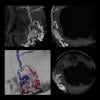This is the newest cardiac cath lab at the University of Colorado Hospital in Aurora, Colorado. Construction was completed in June 2018. It is centered around a Philips Azurion Clarity IQ angiography system, which was chosen because its low X-ray dose imaging and guidance technologies that enable more complex, longer procedures. The room is use for the most involved complex percutaneous coronary interventions (PCI), including chronic total occlusions (CTOs) and complex high-risk indicated procedures (CHIP) patients. It is also used for transcatheter aortic valve replacement (TAVR), septal occluder procedures, transcatheter LAA closures and alcohol ablations.
The room is equipped for radial access procedures, which is used in a little more than 50 percent of cases at the hospital. It is also equipped with an Impella hemodynamic support system, wires and microcatheters for CTOs, and a SonoSite point of care ultrasound console for vascular access needle guidance.
See a 360 Degree View During a CTO Case in this room
Watch the VIDEO: The Evolution of Complex PCI at University of Colorado, which speaks with two of the operators who use this room.
Find more content from the University of Colorado Hospital.








































